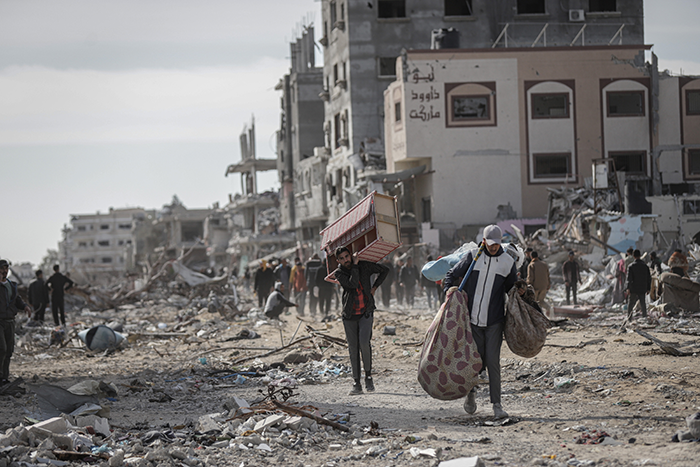Interviews / Human Security
22 January 2025
Gaza: The Humanitarian Crisis Persists Despite the Ceasefire

After 15 months of intense warfare, described by several NGOs as genocide against Palestinians, a ceasefire finally came into effect between Israel and Hamas on Sunday, January 19, brokered by Qatar and the United States. This truce is expected to lead to the gradual release of Israeli hostages kidnapped on October 7, 2023, during Hamas’s terrorist attacks, as well as the release of several hundred Palestinian prisoners held in Israel. Internally displaced persons in the Gaza Strip will also be able to return to their towns of origin, and humanitarian aid is expected to resume its pre-conflict scale.
However, the situation for the population remains extremely concerning. What is the current state of Gaza now that the bombings have ceased? How does the population view this ceasefire? How will humanitarian aid be implemented? Is a gradual reconstruction of Gaza on the horizon? Answers from Jean-François Corty, an associate researcher at IRIS, head of the Humanitarian Rendezvous, and president of Médecins du Monde.
As the conflict in Gaza is currently suspended, what human toll can be established at this time? How is the truce signed between Hamas and Israel perceived by the people of Gaza?
It is important to emphasize that this is a truce, not a peace agreement. This fragile truce is planned in several theoretical phases, beginning with the gradual release of hostages and the delivery of humanitarian aid. Depending on the progress of negotiations, two additional phases are envisioned: one aiming for lasting stability and another for reconstruction. However, no solid political framework has yet been established. Key issues related to the root causes of the conflict, such as active settlement expansion in the West Bank and East Jerusalem, remain unresolved.
Despite these limitations, the ceasefire offers a real respite for civilians, a tangible hope, and relief for the hostages and their families, as well as for the hundreds of Palestinian prisoners set to be released, the majority of whom were detained under questionable circumstances. This truce is also a lifeline for the two million civilians in Gaza who have endured catastrophic conditions over the past 15 months.
The statistics are staggering: this war, unprecedented in lethality, has officially caused at least 46,000 deaths, with an additional 30,000 possible victims according to a recent Lancet article, bringing the total to 70,000 deaths solely from bombings and injuries. This tally does not even account for bodies still trapped under rubble or deaths due to lack of medical care. The humanitarian crisis is of exceptional magnitude: over 90% of the population has been displaced, more than 60% of essential infrastructure has been destroyed, along with 80% of individual homes. The healthcare system lies in ruins, with hundreds of health centers destroyed and at least 20 hospitals completely out of service, leaving only 16 of the 36 hospitals operational before October 7. The remaining hospitals are severely under-resourced and barely functioning.
Humanitarian aid, blocked for months, could have alleviated this extreme situation marked by hunger, thirst, and lack of medical care. Currently, approximately 110,000 people are injured, most requiring urgent care that cannot be provided in Gaza. The local healthcare system, already shattered, is unable to meet these demands.
This truce provides a breather not only for the population but also for humanitarian workers, who have suffered significant losses themselves: at least 300 aid workers, hundreds of medical staff, and 120 journalists have lost their lives. However, this glimmer of hope comes with an ambivalent sentiment. In the West Bank, violence continues to obstruct humanitarian efforts, and tensions remain high.
This truce marks, hopefully, the end of an extremely deadly period of violence, but not the conclusion of the Israeli-Palestinian conflict. It represents a pause in a war that could take another form, leaving many uncertainties about the future.
The signing of the ceasefire is expected to enable significantly more humanitarian aid than during the conflict. What are the priorities in this regard, and how is aid delivery organized?
For the past 15 months, humanitarian aid to Gaza has faced massive obstructions, with drastic restrictions on the flow of trucks. Before October 7, 2023, between 500 and 600 trucks entered Gaza daily, but this number plummeted to an average of 50 to 150 trucks per day. This shortage occurred against the backdrop of a 17-year blockade, which had already plunged the population into forced rationing imposed by Israeli authorities.
Humanitarian priorities are manifold: delivering medicines, medical equipment, food, potable water, fuel for generators, and temporary shelters such as tarpaulins and tents for families returning to devastated neighborhoods, particularly in central and northern Gaza. Efforts must also be made to strengthen functioning hospitals, establish field hospitals, and develop local health centers to address urgent medical needs.
The current agreement aims to restore the entry of 500 to 600 trucks per day, as has been observed since January 19 via the Kerem Shalom crossing. However, this logistical challenge is enormous: roads, storage infrastructure, healthcare facilities, and even agricultural land have been largely destroyed. The United Nations, coordinating this effort with COGAT (the Israeli Coordinator of Government Activities in the Territories), will require Egypt’s support to maintain a continuous flow of aid and allow large-scale entry of humanitarian teams.
Another critical issue will be the evacuation of thousands of severely injured individuals who cannot be treated locally due to the massive destruction of the healthcare system. So far, no large-scale evacuation operations have been implemented, and it will be essential to push for this to change.
Special attention must also be given to the mental health of the population. Over the past 15 months, Gaza’s two million residents have lived in what can be described as an “open-air prison,” subjected to relentless bombings, constant drone surveillance, and immeasurable human losses. Nearly every family has lost loved ones. The collective trauma is immense, and psychological support must be integrated into any comprehensive humanitarian response.
The challenge is thus to organize a gradual and proportional scale-up to meet the needs while considering the constraints imposed by destruction and insecurity. Although the planned 500 trucks per day mark progress, they will not suffice to make up for 15 months of shortages or address the emergency situation Gaza faces today.
What are the long-term prospects for the Gaza Strip in humanitarian terms? How could the reconstruction of the enclave be organized?
Once again, it is important to emphasize that this ceasefire is not a peace agreement. Israeli Prime Minister Benjamin Netanyahu explicitly stated that he reserves the right to resume bombings at any time, in a logic similar to what was seen in Lebanon. This highlights the instability of the situation and the urgency of taking action on multiple fronts.
First, immediate humanitarian needs must be addressed, which is a colossal logistical challenge in a territory where essential infrastructure has been systematically destroyed, where aid has been obstructed, and where living conditions have become inhumane. Reconstruction, however, can only truly begin within the framework of a lasting ceasefire, allowing humanitarian teams and international organizations to work in a secure environment. This includes, as I have mentioned, initiatives to address the psychological trauma of the population, an essential aspect after a period marked by unprecedented violence. We are coming out of a period described as genocide by Amnesty International and Human Rights Watch, with mass killings of civilians, methodical destruction, and widespread repression. Working on grief and mental reconstruction will require active support for international jurisdictions such as the International Court of Justice (ICJ) and the International Criminal Court (ICC), so that they can investigate and prosecute those responsible for the atrocities committed on both sides of the front line. This quest for justice is fundamental to restoring some dignity and trust in the international order.
Moreover, it is crucial to consolidate and support the United Nations Relief and Works Agency for Palestine Refugees in the Near East (UNRWA), which has been targeted both politically and militarily. Hundreds of its members have been killed in bombings, even though this organization plays an indispensable role in helping Palestinian refugees, not only in Gaza, but also in the West Bank, Lebanon, and Syria. UNRWA must be strengthened to continue its vital work, particularly in a context where Palestinian refugees are largely dependent on its services.
Supporting UNRWA and promoting mechanisms related to respect for international humanitarian law and international justice will be essential steps in building a sustainable response to this crisis. Justice, reconstruction, and the respect for fundamental rights must be at the heart of any attempt to resolve the conflict.

